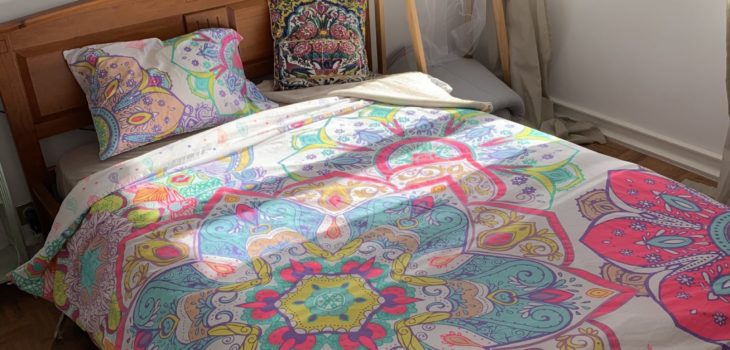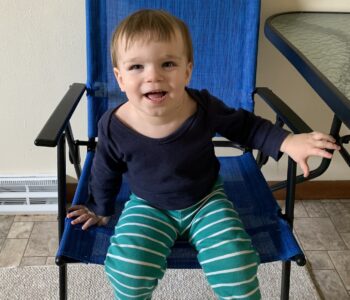
I made my own magic ‘tidying up’ my life…
Among the books I’ve read recently, I enjoyed “The Life-Changing Magic of Tidying Up: The Japanese Art of Decluttering and Organizing” by Marie Kondo.
If you know me personally, you might think this is odd, because I have virtually nothing left to “tidy up.” I don’t have a house or things to fill it.
That’s because I went through my own version of the KonMari Method the year before I read her book.
What is tidying up?
If you haven’t read Kondo’s book (or watched the Netflix series or you’ve been living under a rock and only recently emerged), “tidying up” is Kondo’s process to help clients tidy their homes once and for all. She calls it the KonMari Method. Once you’ve done it properly, you never again will need to “tidy up.”
Basically, you go through everything in your house and only keep those items that “spark joy.” Then, you find the perfect place to store and keep the things that bring you joy. When you finish using an item, you return it to its place. No more bulging closets, piles of papers, unread books, odd collections or hidden “treasures.”
Kondo is Japanese and has focused her methods mainly in Japan, where many of her clients have a room – not a house, and houses are much smaller than typical American homes. She encourages people to tidy at one time – not a little at a time, but all in one go. It’s easier to see the full change and keep the momentum if you do it all at once.
I tidied up my life
When I started to change my life, I wanted to get rid of everything. With a goal to live other places, I knew I couldn’t be weighed down with personal possessions, household goods and a lifetime of accumulation.
My desire to get rid of everything spilled over onto my family, and they, too, got rid of a lot of things – furniture, clothing, electronics, collections, stuff.
We gave away items to Goodwill and other charities. Some of our possessions went to Barrett’s Auctions. Friends and family took some things.
Still, after all of that, I filled a 15-yard dumpster with junk, and I could have filled another one equally with things that we threw out during the process. A 15-yard dumpster is 16 feet long, 7.5 feet wide and 4.5 feet high. Think about how much stuff fits in there.
Here’s the thing. I’m not a “saver.” I didn’t keep everything I’d ever received or bought. Rarely would I buy things – only what we needed. I didn’t have knickknacks, collections or stockpiles. At least every six months, I’d go through cupboards and closets to get rid of stuff we weren’t using and didn’t need. (OK, I ignored the basement and garage, but a lot of that wasn’t “my stuff.” When you have five people living in a house, you have a lot of stuff that doesn’t all belong to you.)
There was no way to do it in one go, as Kondo would have suggested. It was a months-long process, but I was determined and didn’t stall. It had to go.
KonMari and me
As I read Kondo’s book, I realized I followed many steps of her KonMari Method without knowing it. I started with clothing. Holding each piece, I decided if I really “loved” it. I didn’t know at that time about “sparking joy,” or I would have used that terminology.

I kept a few clothing items that didn’t I didn’t love, but I felt I would need them. Since then, I’ve gotten rid of those pieces, as well as some I loved but wasn’t wearing.
Then, I moved on to other things. Of course, I knew I had limited space to store or keep anything, so I really was ruthless about what I was willing to keep. An item had to have great meaning or be extremely useful to make it into my “keep” pile.
Having a specific place for everything was important. I disliked having to search for something, so I knew if I kept it in the same place, I’d always know exactly where it was. Instant tidying. Do it once, and you don’t have to it again — ever.
This worked equally well for me when I lived in Portugal. I had many fewer things, but it was important to always put things back, so I would know right where they were. I never had to “tidy up,” just make my bed, sweep and do laundry.
Does it spark joy?
The things I own now all fit in or on my car. Most of my possessions fit in the trunk. The paintings take up the backseat, and my bicycle goes in the rack on the trunk.
For the most part, the things I have spark joy. Those that don’t are utilitarian. Even most of those bring me joy, though.
When I started house-sitting, I created a cache of items I needed that weren’t always readily available where I was living: a small silicon spatula, a good paring knife, a corkscrew, tea supplies, spices, a wine glass, a shot glass, a drink glass, measuring cups and spoons, a pan scraper, my Bialetti coffee maker and espresso cup/saucer. These things all “spark joy.” I am pleased when I see, hold and use them. They serve a purpose, and I get joy from them.
What tidying up is not
Tidying up is not minimalism or even functionalism.
Minimalism is a philosophy of living life based on experiences rather than possessions. Functionalism is a doctrine that an object’s design should be based solely on its function, not how it looks, and that anything practically designed will inherently be beautiful.
While Kondo talks about how many bags of trash her clients throw out after “tidying up,” the focus isn’t on what’s discarded but on what remains. Clients can keep anything that brings them joy – even odd things that other people would toss quickly.
There is no requirement that something be functional or even beautiful. It simply has to bring joy to the owner.
KonMari isn’t about minimalism or functionalism. Once you tidy up, your space will feel different and look different, but it may not be minimalistic. And what you keep may not be functional. I have a number of paintings that either my sister or I painted. They are not functional or minimal, but they bring me joy, so I keep them.
Why tidying won’t work for Americans
I read an article while researching this that “tidying up” won’t work for typical American women. The author’s chief points are that we have bigger houses, more stuff and families. (If you have four bathrooms, you need supplies for four bathrooms.) Kondo is a younger person at a different point in her life and hasn’t accumulated as much as middle-age American women.
That’s all true, but that doesn’t mean tidying won’t work. Kondo doesn’t say you have to get rid of possessions if they bring you joy. But how many of us have things in our houses that we don’t need, don’t use and take up space? If those items were gone, and we had a plan for where to store everything else, how different would our homes look? Even our big American homes with too many rooms and too much stuff?

That’s the rub, though. I see people acquire things, and it’s not for me. Too often people buy things just to buy them. Shopping is a feel-good addiction for some people. While there’s nothing wrong with shopping, sometimes that is where the joy begins and ends. The joy of shopping doesn’t carry over to the items purchased.
Kondo’s clients range from young people to older people, including families with children, singles and couples.
It could work for Americans, even middle-age women with big houses and families – look at me. But you have to want to do it, and that’s what most Americans wouldn’t want to do. They don’t want to get rid of their stuff, they just want it magically to be tidy.
The magic in the book title, by the way, is about what happens in your life after you tidy up. Kondo’s clients have found their true callings, true lives and true selves after tidying up their physical surroundings. This was most interesting to me, since I experienced a similar “magic.”
My tidying take-aways
I know the KonMari process for tidying up won’t appeal to most people. It’s a dramatic change that requires a shift in thinking and a desire for change to occur. That’s a hard sell.
No, most people would rather watch her Netflix series and see someone else undergo a transformation. We hope we pick up a tip or two, but we really aren’t willing or even interested in doing it ourselves. It’s like watching any home improvement show. The results are stunning, but we’re pretty sure we couldn’t do it.
That said, I do have some takeaways or tips that anyone can use, even if you don’t follow her method or read the book.
- First, don’t acquire something if doesn’t spark joy. Note, I didn’t say “buy” I said “acquire.” Often, others give us things they no longer want or need, or we receive gifts. For example, I recently acquired slippers when someone ordered a pair that was the wrong size.
(Kondo has a section on gifts that don’t spark joy. We experienced joy when we received the gift, and the giver experienced joy in giving it, so the item has served its purpose. It’s OK to let it go.)
- Second, don’t keep it if it doesn’t spark joy — whatever it is.
Clothing is the easiest, most obvious and first item Kondo addresses in her book. If you don’t love the shirt, pants, dress, skirt or shoes, why keep it? Only keep those clothing items you love and wear. However, only donate used clothing in good condition that someone will wear. If it’s torn, missing buttons, stained, out-of-date or a freebie T-shirt, make it into rags instead.
- Finally, this is my own tip, not from the book: Borrow instead of buy. If you need an item one time or once in a while, can you borrow it instead of buying it? This works for tools, small kitchen appliances, luggage, occasional items (such as card table and folding chairs, party supplies, games) and dressy clothing. You probably will think of other things, too!
If you haven’t read the book, I encourage you to check it out. It’s a quick read. If you give her KonMari Method a try, let me know how it goes! I’d love to know how the “magic” transforms your life.
How to Be a Better Writer Tip
Make a simple outline using sub-heads
If you need to write something – a blog post, a long email, an article for the work newsletter, a brochure, a school assignment – you can create a simple outline to get you started and keep you on track.
Write the sub-heads you want to include, then go back and fill in with the detail.
I do this for my blogs. I spend a couple of minutes thinking about what I want to talk about in the blog post, the highlights of the article, and try to capture them in sub-heads. (You could write sentences, if you wish.)
This process takes less than 5 minutes, but it has big benefits:
Benefits of writing sub-heads
- Sub-heads are good for longer articles, because they break up the copy. An article is easier to read on paper, in email and on websites if it isn’t just a big block of type.
- Sub-heads help your readers see your topics and know where you’re going with an article. Readers can use sub-heads to get the gist of it and jump to the next section if they don’t have time to read the whole thing.
- Sub-heads help me stay on topic. If you tend to stray in your writing or get off track easily, sub-heads will help keep you focused.
- Sub-heads help me stay organized. Sometimes, I will write several paragraphs, and realize they would fit better under a different sub-head. The sub-heads can help me organize an article better.
- Sub-heads get me started. Sometimes, I’m not sure where I want to start writing. I don’t always have a “lede,” or opening sentence in mind. Rather than focus on that, I can jump into writing under any of the sub-heads, to get the process going. Usually, a good lede will turn up in my writing, and I move it to the top.
- Sub-heads help me finish. When I run out of sub-heads, I know I should wrap it up.
- Sub-heads help me answer all the questions readers may have. What questions would I have as a reader of this blog about this topic? Then I include them as sub-heads. This helps me produce a more complete blog post.



